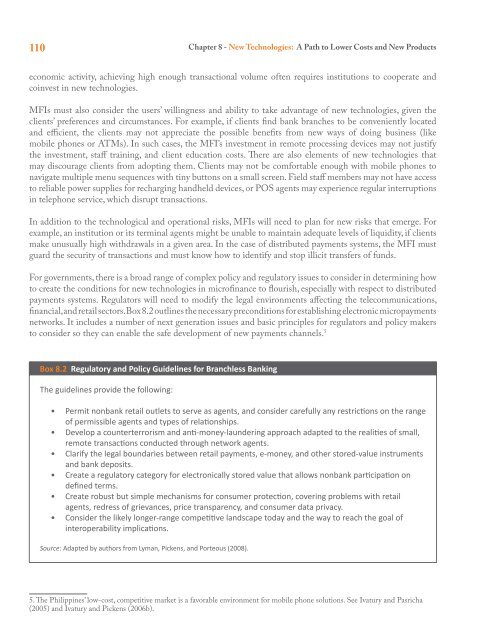managing risk.pdf
managing risk.pdf
managing risk.pdf
Create successful ePaper yourself
Turn your PDF publications into a flip-book with our unique Google optimized e-Paper software.
110Chapter 8 - New Technologies: A Path to Lower Costs and New Productseconomic activity, achieving high enough transactional volume often requires institutions to cooperate andcoinvest in new technologies.MFIs must also consider the users’ willingness and ability to take advantage of new technologies, given theclients’ preferences and circumstances. For example, if clients find bank branches to be conveniently locatedand efficient, the clients may not appreciate the possible benefits from new ways of doing business (likemobile phones or ATMs). In such cases, the MFI’s investment in remote processing devices may not justifythe investment, staff training, and client education costs. There are also elements of new technologies thatmay discourage clients from adopting them. Clients may not be comfortable enough with mobile phones tonavigate multiple menu sequences with tiny buttons on a small screen. Field staff members may not have accessto reliable power supplies for recharging handheld devices, or POS agents may experience regular interruptionsin telephone service, which disrupt transactions.In addition to the technological and operational <strong>risk</strong>s, MFIs will need to plan for new <strong>risk</strong>s that emerge. Forexample, an institution or its terminal agents might be unable to maintain adequate levels of liquidity, if clientsmake unusually high withdrawals in a given area. In the case of distributed payments systems, the MFI mustguard the security of transactions and must know how to identify and stop illicit transfers of funds.For governments, there is a broad range of complex policy and regulatory issues to consider in determining howto create the conditions for new technologies in microfinance to flourish, especially with respect to distributedpayments systems. Regulators will need to modify the legal environments affecting the telecommunications,financial, and retail sectors. Box 8.2 outlines the necessary preconditions for establishing electronic micropaymentsnetworks. It includes a number of next generation issues and basic principles for regulators and policy makersto consider so they can enable the safe development of new payments channels. 5Box 8.2 Regulatory and Policy Guidelines for Branchless BankingThe guidelines provide the following:• Permit nonbank retail outlets to serve as agents, and consider carefully any restricons on the rangeof permissible agents and types of relaonships.• Develop a counterterrorism and an-money-laundering approach adapted to the realies of small,remote transacons conducted through network agents.• Clarify the legal boundaries between retail payments, e-money, and other stored-value instrumentsand bank deposits.• Create a regulatory category for electronically stored value that allows nonbank parcipaon ondefined terms.• Create robust but simple mechanisms for consumer protecon, covering problems with retailagents, redress of grievances, price transparency, and consumer data privacy.• Consider the likely longer-range compeve landscape today and the way to reach the goal ofinteroperability implicaons.Source: Adapted by authors from Lyman, Pickens, and Porteous (2008).5. The Philippines’ low-cost, competitive market is a favorable environment for mobile phone solutions. See Ivatury and Pasricha(2005) and Ivatury and Pickens (2006b).
















